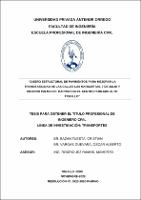Mostrar el registro sencillo del ítem
Diseño estructural de pavimentos para mejorar la transitabilidad de las calles Las Margaritas, 7 de Julio y Ricardo Palma del Barrio 1 en el Centro Poblado Alto Trujillo
| dc.contributor.advisor | Rodriguez Ramos, Mamerto | |
| dc.contributor.author | Bazan Tuesta, Cristian | |
| dc.contributor.author | Vargas Guevara, Oscar Alberto | |
| dc.creator | Bazan Tuesta, Cristian | |
| dc.date.accessioned | 2021-01-26T14:38:20Z | |
| dc.date.available | 2021-01-26T14:38:20Z | |
| dc.date.issued | 2021 | |
| dc.identifier.uri | https://hdl.handle.net/20.500.12759/7092 | |
| dc.description.abstract | La presente investigación se desarrolló en las calles las Margaritas, 7 de Julio y Ricardo Palma del Barrio 1 en el Centro Poblado Alto Trujillo, mediante una investigación de tipo aplicada. El objetivo principal fue realizar el diseño estructural de pavimentos mediante la metodología AASHTO 93 para mejorar la transitabilidad, para lo cual se observó y analizó las condiciones en la zona de estudio. En este proyecto se diseñó el pavimento flexible y rígido. Además, se tomó en cuenta las recomendaciones establecidas en el Manual de Carreteras: Suelos Geología, Geotecnia y Pavimentos, el Reglamento Nacional de Edificaciones: Norma CE.010 Pavimentos urbanos y Norma GH.020 Componentes de Diseño Urbano, las cuales sirvieron para establecer los espesores de cada una de las capas del pavimento y también la sección vial de cada calle. Se realizaron estudios básicos de ingeniería como el estudio de mecánica de suelos, con lo que se determinó que el suelo es una arena pobremente gradada y presenta un CBR de 21.8%; y el estudio de análisis de tráfico, con lo cual se obtuvo que el número de repeticiones de ejes equivalentes de 8.2 tn para el pavimento flexible es de 1,517,500.49 y para el pavimento rígido de 1,587,746.93. Los resultados obtenidos del diseño estructural del pavimento flexible es una carpeta asfáltica de 7.5 cm, base de 20 cm y una subbase de 10 cm, con un costo de S/. 2,584,807.35 y con 114 días de tiempo de ejecución; para el pavimento rígido se tiene una losa de concreto de 20 cm y una base de 15 cm, con un costo de S/. 3,259,059.76 y con 140 días de tiempo de ejecución. Finalmente se concluye que el pavimento flexible presenta un costo y tiempo de ejecución menor al pavimento rígido, lo cual lo hace más conveniente desde el punto de vista económico y constructivo, pero requiere mayor costo de mantenimiento. | es_PE |
| dc.description.abstract | The present investigation was developed in the streets of Las Margaritas, 7 de Julio and Ricardo Palma del Barrio 1 in the Alto Trujillo Town Center, through an applied investigation. The main objective was to carry out the structural design of pavements using the AASHTO 93 methodology to improve walkability, for which the conditions of the area are qualified and analyzed. In this project the flexible and rigid pavement was designed. In addition, the recommendations established in the Manual of Roads: Soils, Geology, Geotechnics and Pavements, the National Building Regulations: Standard CE.010 Urban Pavements and Standard GH.20 Urban Design Components were taken into account, which served to establish the thickness of each of the layers of the pavement and also the road section of each street. Basic engineering studies were carried out, such as the study of soil mechanics, with which it was determined that the soil is a poorly graded sand and presents a CBR of 21.8%; and the traffic analysis study, with which it was obtained that the number of repetitions of equivalent axes of 8.2tn for flexible pavement is 1,517,500.49 and for rigid pavement it is 1,587,746.93. The results obtained from the structural design of the flexible pavement are a 7.5 cm asphalt layer, a 20 cm base and a 10 cm subbase, with a cost of S /. 2,584,807.35 and with 114 days of execution time; for the rigid pavement there is a 20 cm concrete slab and a 15 cm base, at a cost of S /. 3,259,059.76 and with 140 days of execution time. Finally, it is concluded that flexible pavement has a lower cost and execution time than rigid pavement, which makes it more convenient from an economic and constructive point of view, but requires a higher maintenance cost. | en_US |
| dc.description.uri | Tesis | es_PE |
| dc.format | application/pdf | es_PE |
| dc.language.iso | spa | es_PE |
| dc.publisher | Universidad Privada Antenor Orrego - UPAO | es_PE |
| dc.relation.ispartofseries | T_ING.CIVIL_1897 | |
| dc.rights | info:eu-repo/semantics/openAccess | es_PE |
| dc.rights.uri | https://creativecommons.org/licenses/by/4.0/ | |
| dc.source | Universidad Privada Antenor Orrego | es_PE |
| dc.source | Repositorio Institucional - UPAO | es_PE |
| dc.subject | Diseño estructural | es_PE |
| dc.subject | Pavimento flexible | es_PE |
| dc.subject | Pavimento rígido | es_PE |
| dc.subject | Transitabilidad | es_PE |
| dc.title | Diseño estructural de pavimentos para mejorar la transitabilidad de las calles Las Margaritas, 7 de Julio y Ricardo Palma del Barrio 1 en el Centro Poblado Alto Trujillo | es_PE |
| dc.type | info:eu-repo/semantics/bachelorThesis | es_PE |
| thesis.degree.grantor | Universidad Privada Antenor Orrego. Facultad de Ingeniería | es_PE |
| thesis.degree.name | Ingeniero Civil | es_PE |
| thesis.degree.discipline | Ingeniería Civil | es_PE |
| dc.subject.ocde | http://purl.org/pe-repo/ocde/ford#2.01.01 | es_PE |
| renati.advisor.orcid | https://orcid.org/0000-0003-3024-0155 | es_PE |
| renati.author.dni | 71340840 | |
| renati.author.dni | 72435847 | |
| renati.advisor.dni | 18034417 | |
| renati.type | http://purl.org/pe-repo/renati/type#tesis | es_PE |
| renati.level | http://purl.org/pe-repo/renati/nivel#tituloProfesional | es_PE |
| renati.discipline | 732016 | es_PE |
| renati.juror | Lujan Silva, Enrique | |
| renati.juror | Cancino Rodas, Cesar | |
| renati.juror | Urteaga Garcia, Juan | |
| dc.publisher.country | PE | es_PE |
Ficheros en el ítem
Este ítem aparece en la(s) siguiente(s) colección(es)
-
Ingeniería Civil [1085]


